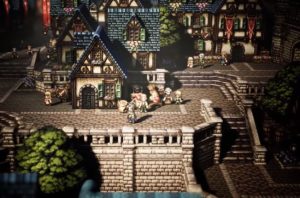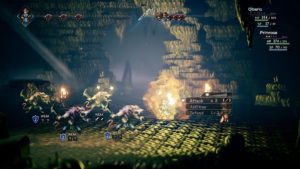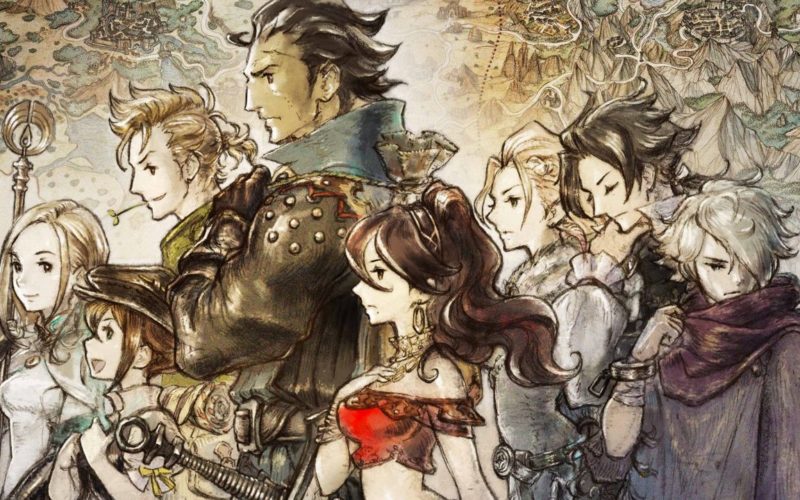Before I decided to travel on a holiday I thought to myself that I needed to use my switch more. While searching through the library of games on offer to me I came accross a curious title known as Octopath Traveller that looked absolutely gorgeous and I had heard good things about. From this (although I was a bit hesitant about the price) I thought this would be a good timesink inbetween bus journeys so I purchased it solely for this trip. Little did I know that this would turn out to be one of my favourite RPG’s I have played in recent years. I went on a journey myself and played a game all about travelling, truly it was a match meant to be. How does it stack up as an experience in my critical eye however?
The story of Octopath is a little complicated to explain as it really is eight different stories in one. You play as a party of characters comprised of eight seperate people with their own class and abilities (hence the title of the game). These stories range from your typical knight fighting evil and searching for truth to the unique revenge plot of an exotic dancer hunting down her father’s killers. The stories are nothing revolutionary however they provide a simple enough backdrop for becoming engaged in the plot and give each of the characters enough depth and relateable features that I can easily remember each of the main heroes and what their stories were. It also adds to the fact that the world you are in, Orsterra, has plenty of locales, interesting locations and ancient lore that it makes for an fascinating world even if by some standards it can be considered a traditional medieval fictional world (complete with silly dialect and all!).

The presentation of this game is certainly something to behold. While it does style itself after classic Square Enix RPG’s by going for a pixellated look it helps to modernise the format by making it into a fully 3D landscape with beautiful lighting and incredible detail in all the pixel work shown off. Indeed this was the main thing that instantly drew me to the game in the first place as seeing an incredible mix of both old and new styled visuals makes for a very unique looking game. Every time I entered a new locale I always took in the sights and audibly told myself just how pretty this game looked. Maybe I’m just a sucker for retro graphics done correctly but I think this may very well be one of Octopath’s greatest features. The music too is outstanding as when my girlfriend mentioned how she was enjoying the battle theme and humming it to herself while out shopping you know you’re onto a winner. A lovely mix of classical instruments to create a wonderous orchestrated soundtrack that I adored from start to finish. There is voice acting present too however strangely enough it’s only used in important story moments or character development sections, otherwise it’s simply abridged phrases and grunts being used. I found this mix slightly jarring as I felt as though the constant jumping between voiced and unvoiced dialogue made for an experience that wasn’t quite sure of what it wanted to do. I would have much preferred if it had either stuck to fully voiced dialogue or simply text as either one would have made for a more flowing experience during dialogue however this is simply a small gripe. The variety of enemies and characters you meet is astounding, as should be expected from a classical-style JRPG, and even when you start to see variations on the same enemy type they are distinct enough by adding new armor pieces, clothing, weapons or even simply additional battle scars that it makes each new enemy unique enough to stand out. Bosses too are a particular highlight as there are so many boss fights that the visual style surrounding each of them is unique and incredible. No two bosses ever felt the same, and that is an accomplishment in itself.
The gameplay of Octopath is doing what Square does best, turn based classic RPG mechanics. The twist this time is the inclusion of a unique turn and ‘break’ system. Essentially every enemy in the game is weak to certain weapons/magic and also have a certain number of hits they can take from these damage types until they eventually are stunned and cannot move for a whole turn. It encourages use of several characters with different types of damage so that you can get free hits on an open and weakened enemy fighter. This also makes weaker characters that aren’t into damage useful too as they can focus on simply causing enemy defences to break while the damage dealers unleash massive attacks on open opponents. You can also charge up your moves by using ‘Battle Points’ that you gain at the end of each turn. These allow you to either attack multiple times in a row or unleash powered-up versions of your special abilities. This added complexity into the combat system alongside the variety of character classes, due to the inclusion of eight different party characters, means that fights can become very complex and tactical, especially during boss fights. This however does mean that fights can drag out for a long time and this is especially compounded by the large health pools of some enemies. While for some this increased battle time is more enjoyable it can lead to frustrating moments when you are stuck trying to cross an area and keep having to deal with random encounter fights that can last more than five minutes each. Still despite this I thoroughly enjoyed the combat system as it made boss battles all the more exciting. All these new mechanics and fine-tuned gameplay additions and large amount of main and side quests make for a complex JRPG that is incredibly fun and rewarding to master.

The biggest problem I feel the game suffers from however is repetition. Now personally this wasn’t too much of a concern for myself as I enjoyed the regimented system of knowing how each new quest would be structured however I can see how this might become a massive problem to some. Each new chapter in one of the character’s story plays out like this: Enter a new town, begin story section, use character’s unique ability in town to solve a plot dilemma, through story find location of a dungeon/area nearby that is relevant to the plot or character, go to the dungeon/area and fight to the boss until eventually you beat them and the story concludes for that area. Obviously there are exceptions however this system is so similar to every new part of the story that it makes for a very samey-feeling type of journey. When you know that a child mentioning a great beast in the nearby woods means that’s the dungeon you will go to and that’s the boss you will fight it can sap some of the fun of discovery out of the game. This combined with the classical and slow combat system could make some people feel fatigued over the repetitiveness of each new encounter which is certainly a downside that this game faces. Still I feel as though it doesn’t detract from the game too much as, like I said, personally I like the structure that is presented and it certainly helps me to manage time better when inbetween sessions of the game.
Overall then Octopath Traveller is an amazing achievement for Square as they have finally gone back to their roots and done what they are truly best at, making a compelling, complex and massive RPG with memorable characters and exciting combat. The sting of repetitiveness does tend to sink in every now and then but it doesn’t stop this from being one of the best games in the genre that I have played in a very long time. Plus take into account that you’re certainly getting your money’s worth with the amount of time you will sink into this game. If you’re an RPG fan who owns a switch then I implore you to try out Octopath and prepare to lose your life over the many hours you will spend in this fantastic game.

